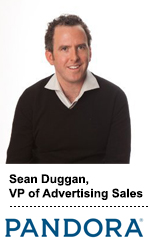 Political ad dollars, even more so than brand budgets, have conglomerated around a handful of major players.
Political ad dollars, even more so than brand budgets, have conglomerated around a handful of major players.
Of the more than $1 billion analysts predict candidates and super PACs will spend online this election, “half will go to Facebook and Google, Pandora – those are the big ones – and Twitter,” said Jordan Lieberman, politics and public affairs lead at the political targeting firm Audience Partners, at AdExchanger’s PROGRAMMATIC I/O earlier this year.
To those outside of political digital media buying, Pandora may look like the outlier in that group. But the music platform has assembled a strong value prop for political advertisers.
For example, when the liberal super PAC Priorities USA Action, the primary PAC supporting Hillary Clinton’s campaign, kicked off its general election media plan in June, it spent $500,000 with two digital platforms: Facebook/Instagram and Pandora.
AdExchanger spoke with Sean Duggan, Pandora’s VP of ad sales who has led the political sales group since its inception in 2012, about the company’s inroads to Washington, DC, ad budgets.
What’s been important for Pandora this year in securing political ad dollars?
The big thing is that we’ve been at it a while. We started our political advertising focus in 2012, and did about 200 campaigns that cycle. You have to be able to map your solution to political needs. And campaigns aren’t going to be testing your product or media right now. It isn’t launching a consumer product offer. If you aren’t tested in the primary or earlier, they aren’t going to test you in the election. If you don’t have people in DC who know the market and you’re just setting up tent for the election, then forget about it. [This is some shade cast toward Pandora’s main rival, Spotify, which started its programmatic business last year and is working on its first political ad offering.]
Without experience in the space, you’re not going to have the robust client services political spenders need. Speed is essential for campaigns: An opponent said something this morning and if the campaign isn’t up now they aren’t interested. The pace of the news and the advertising opportunity cycle in politics is just different, and it takes time to develop.
What’s the selling point or format that campaigns and super PACs want? What is the market pushing for?
The first thing is targeting. Almost all campaigns are state or local, and they want their district, voting ages, verified zip codes. Campaigns trust that monthly credit card more than online profiles. Hispanic voters in a Florida district? That’s an easy solution for us. And it’s key in some states, like New Hampshire, where for TV you’re probably buying pricey Boston market spots and getting a lot of waste on that spend.
But that’s actually not where I see Pandora differentiating itself.
There’s so much focus on targeting in the market, but we see it as a complement, not the main sell. We’ll do the straight-up voter-file matching, but for me it’s about our data scientists modeling our proprietary data, what we can do within our own walled garden. How do we apply the data set of how someone is listening? Is it through a hybrid or SUV? A lot of the vendors in the digital space, ad networks and tech firms, they have a conundrum because the only way to tap into political budgets is [through] reliable data matching, but it severely limits their scale. Everyone in digital just wants to help a campaign hit the bullseye, but we want to do that and also get the next rings.
What about formats? You have display, video and an audio option akin to radio, so what’s the difference between a plan for a political advertiser compared to a commercial brand?
The highest demand currency in the political market is definitely video – though in the broader marketplace, TV still has an absolutely dominant position. The thing that makes us unique is there aren’t a lot of platforms out there for audio. We only play the video off of an actual user interaction. They skip a song or change the playlist so we know they’re engaged, and it’s a non-skip, full-sound ad that runs for 15 seconds, with another potential 15 seconds after that if the user doesn’t skip. That’s something campaigns want and have trouble getting online or in apps.













